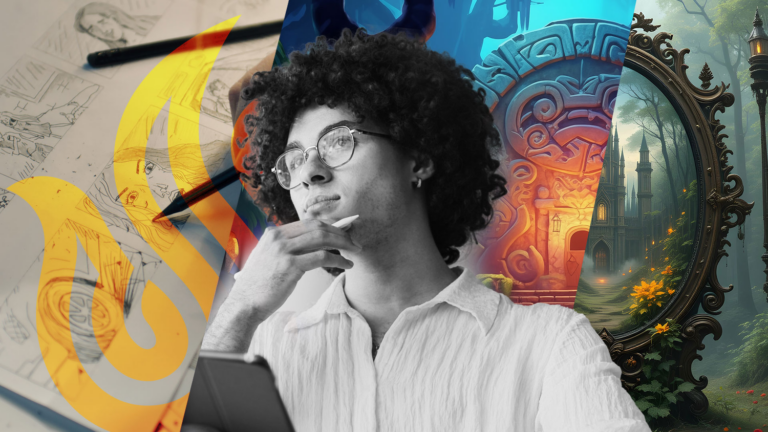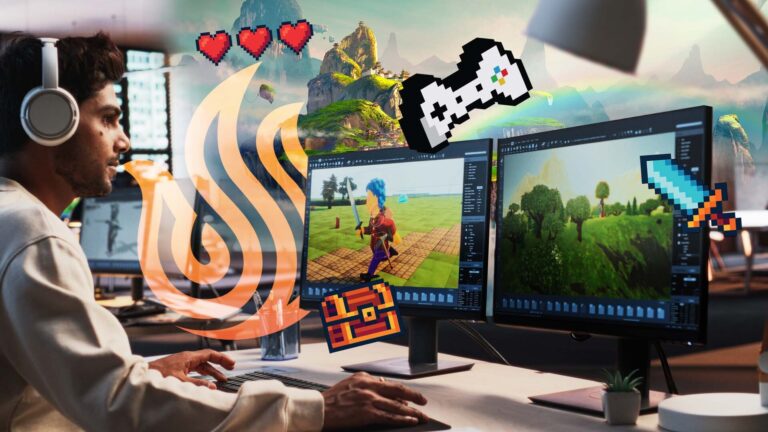Of all the artistic mediums, video games may offer the most freedom for creative expression. The active participation inherent in every game provides a world of new ideas for artists to explore. While just about everything has been done before in a passive entertainment medium like television, the possibilities introduced by the element of player choice are an opportunity for video game designers to explore. When it comes to introducing new ideas to the art world, video games are a creator’s chance of doing something innovative.
What Does a Game Designer Do?
Video game designers are assigned a wide array of tasks depending on which point of the development pipeline they enter. You may be with a project from the beginning or be brought on in the middle of development. Timing is a major factor in how tasks get doled out amongst designers. As you may have guessed, each task involves creating or enhancing a portion of the digital world or game mechanics.
Basic Game Design
Game designers may be asked to code functions for gameplay, create art assets, or design interesting level scenarios. There are also many smaller tasks that are not readily apparent. Creating basic animations for objects like doors, adding light sources to each scene, and enhancing each asset with more detail are all examples of these smaller tasks. Despite being small, each assignment is vitally important to the quality of the game. Each part of the world must have a similar level of quality to avoid random elements standing out. Even the optional rooms and secret areas must be polished with the same level of detail as the critical path through the story.
Quality Interactive Experience
In real life, each part of the world behaves in a way you expect. Ultimately, game designers are tasked with making the digital world, that players will explore, as believable as possible. Little details and interactions can be added to make the world more engaging, all while creating a gameplay loop that is as satisfying as possible. A believable world plus an addictive gameplay cycle equals a quality interactive experience.
Communication Skills
In addition to your technical skills and creative vision, you must also learn how to communicate in order to be an effective game designer. Modern video game titles require hundreds of people to work on a project. You will collaborate with fellow designers, detail reports for your bosses, and negotiate with the people in charge of the money. In each case, you must remain professional and keep the whole team in the loop. Learning to mediate arguments, listen actively, and clearly convey your ideas is mandatory when working in large teams. Luckily, even if you are an introvert, you will not need to worry. Plenty of your fellow designers will also be introverts, as well as sharing most of your interests. Talking to other artists and coming up with ideas will be easier than you think.
How Do You Come Up with Video Game Ideas?
An interesting idea is easy enough to come up with. Everyone has randomly come up with something that they would like to see in a movie or video game. The real challenge is implementing that cool idea in the broader context of a complete game. Anything you add to a video game experience will inevitably affect everything else in the title. This means a great idea alone is not enough. A clever way to implement the idea is also required. Execution is everything in the world of game development.
Brainstorm and Record Ideas
The first thing you must do is collect your ideas and store them for easy reference later. When you come up with unique concepts and ideas, it is all too easy to forget them by the time you sit down to work. Writing down any thought you may use later is the ultimate practice for game designers. Have a pocket notebook handy or use your phone to jot down ideas as they come to you. Make this a priority as you will forget your ideas if you wait several hours to write them down. Take a few seconds to write, the moment an idea comes to you.
To get more ideas, you should purposely go to unfamiliar locations and try new activities. You will be hard-pressed to find inspiration in your same old daily routine. Instead, take different routes while commuting and plan to do things you have never done before. The life experience will translate to new game ideas organically. You will learn new skills and be introduced to concepts you would have never seen otherwise. The real world is a treasure trove of inspiration for virtual ideas and game scenarios. Just remember to write everything down as new thoughts form in your mind.
Pre-Production Brainstorming
In addition to your own personal discoveries, you will also generate ideas with your fellow designers during the pre-production phase of development. A game design document is used to catalogue the main features that must be addressed during development. Game designers collaborate to finish the game design document before proper work on the title begins.
Bouncing ideas off multiple team members is an effective way to enhance your game. Often, ideas can be combined and altered based on what multiple designers add to a discussion. The key here is to be confident enough to speak your mind while also remaining rational should your idea be met with opposition. The ability to compromise and place emotion to the side is crucial when brainstorming ideas. When done effectively, the pre-production room can lead to some of the best ideas that shape a project.
Gameplay Experimentation and Glitches
Once proper development in the digital space begins, there is still room to come up with and implement new ideas. Just think of all the post-launch patches and updates that modern games receive. In truth, each stage of development works in the same way. As more people try the game and add new elements, more information is obtained by the development team. For instance, say everyone who picks up the controller attempts to climb ledges by jumping near them. If a ledge pull-up feature was not within the original scope of the game, it may be added later based on playtest feedback.
You may also stumble into clever ideas while encountering the inevitable bugs and glitches that occur during development. As an example, the physics engine may break as you kill an enemy, resulting in the body flying backwards with great force. Although this is an unintended glitch at first, the spectacle of it all may be immensely entertaining. An event like this may influence a developer to add ragdoll physics or increase the degree to which the player’ attacks knock enemies backwards. If a glitch results in something funny, cool, or satisfying, it may be a good idea to add a similar feature into the game, intentionally.
How Do You Become a Game Designer?
By far, the simplest way to become a game designer is by attending a creative arts college. There you can enroll in a game design engineering degree program. Upon graduating, you will have familiarity with the many aspects of the game design process. You will also have experience with the hardware and software used by professionals. These advantages make getting your foot in the door so much easier than if you learn game design on your own.
It may be tempting to self-study, but the various online tutorials wildly differ in quality. You may get both solid advice and outdated misinformation within the same video. These creators are often hobbyists with zero chance of preparing you for a professional career. Contrast this with the highly curated curriculum enjoyed by game design students. Your degree program is carefully constructed by industry veterans who know what employers want to see from new recruits. By training the right way, you can join the workforce without any awkward setbacks.
What Do You Learn During a Game Design Engineering Program?
A game design degree program starts by teaching you the foundational concepts that all developers must know before working in digital space. You will learn how to generate ideas, assess how viable it is to implement them, and how to communicate your ideas to the team. You must convince others that your ideas are good enough to implement. Studying pre-production will help you do just that.
Light Coding
All game designers need to learn some coding, even if you do not plan to become a specialized programmer. You will start by modifying existing game engines and projects to become familiar with the way digital worlds are constructed. With some experience under your belt, you will begin to develop your own engines. Having your own engine allows you to customize the code running the game. Customized game engines are often the only way to implement unique ideas effectively. If an existing piece of software does not facilitate your needs, create a new one that does.
Game Design Philosophy
The philosophy of game design is also covered in depth. What makes a game fun? How do you balance key factors like damage output, ammo, and health? What makes a story engaging? All of these questions and more will be answered. This knowledge will help you deconstruct what works in other games and implement fun or satisfying experiences in your own titles.
Usability and Interface Design
In addition to a fun or interesting game, the software itself must be intuitive and simple to use. Usability and interface design will be explored throughout the curriculum. You will learn how to make menus and icons that instantly show the player how to interact with the game. This includes things like tutorial pop-up text for more complex gameplay mechanics. It also includes the design of heads-up display elements and in-game map systems. Ideally, a player will never get frustrated while trying to navigate the menu or perform basic actions like switching weapons. The popularity of games like Call of Duty is largely due to how simple it is to pick up and play. Usability will dramatically increase the appeal of your final product.
Now that you know how to come up with video game ideas, take the time to learn more about the University of Silicon Valley. As the video game industry continuously grows, employers are zeroed in on Game Design and Development Degree program students who understand both the creative and technical sides of the industry. Nowhere is University of Silicon Valley’s unique ability to combine specializations better demonstrated than in our school’s Game Design & Development Department.
University of Silicon Valley is uniquely poised to offer a meaningful and valuable education for 21st century students. We believe in an education that directly correlates with the work you’ll be doing after you graduate. Interested in learning more? Contact Us today.


